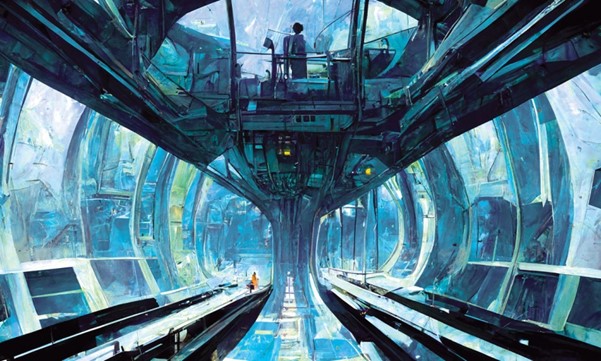
As artificial intelligence continues its creep into the art world, an Adelaide artist is blurring the lines between machine and man-made art.
Dave Court is no stranger to emerging technology.
The Adelaide-based artist regularly incorporates tech into his technicolour works. He’s previously dabbled with Web3, virtual reality (VR), and soundscapes, but his latest exhibition saw him dive into the world of artificial intelligence (AI).
Called Learning Machine, the work questions the act of creation for the latest era of artists braving the new world of algorithms and machine learning.
Dave devised the piece after being given access to an early build of DALL-E – an algorithm that accesses an enormous pile of data in order to mimic and generate images.
Exhibited in Sydney, Learning Machine saw Dave feed his existing work into the algorithm, which then spat back out some ‘Dave Court’-style images – all somewhat alike but eerily computer-generated.
He then turned those AI-made images into paintings and digitally rendered reflections of those paintings, questioning in the process the act of making art with AI tools, and whether an algorithm is capable of creating ‘good’ art.
The artist says the work was a continuation of his ongoing practice, which aims to understand processes and tools through art.
“Whether its AI, VR or Blender, it’s all about understanding the process,” Dave says.
“I feel myself more and more drawn towards the idea of media as the message, and here, it’s like, where does the creation happen? I think a lot of the conversation around these tools is, ‘Is what the AI makes art?’ And I find that quite boring – if you decide something is art, it is. It’s a dead question.
“But here, it’s more of ‘Who does it belong to?’ or ‘Who is the creator?’ Because if I put my art into the AI and it makes a thing, then yeah, I’ve made it. But if someone else puts my artwork into the AI and makes something else, then is that any different?”
Dave’s work centres the myriad of ethical and philosophical quandaries raised by the emergence of AI as an artistic tool, and comes amid ongoing discussions of automation in industries beyond art.
Where technologists would have us believe machine learning and automation will liberate workers from the mundanity of labour-intensive, repetitive work, the reality is potentially millions of jobs will be lost as a result.
Research by Oxford University suggests up to 47 per cent of jobs are “at risk” thanks to automation. As these AI tools become more commonplace for non-artists to use, we’re left to wonder if there’s an existential threat to those whose occupation is ‘artist’.
According to Dave, there will always be demand for art created by people.
“Art is very reputation based. If someone is buying a painting, a lot of the time they’re buying it because they engage with the artist in a certain way, or [the artist’s] reputation,” he says.
“But what if you got to the stage of seamless reproduction? Maybe you’d be losing something then. But then is it just like having knockoff or bootleg prints of something? It might look identical, but it’s still a bootleg.”
Ultimately, Dave describes programs like DALL-E as ‘tools’ – there to be used by an artist. After all, these programs do require human input in order to generate something.
In this way, they can be thought of in the same vein as a camera – though the lens, light and film does all the work in ‘creating’ a picture, it requires human input to select the shot, dial in aperture and focus. Even the selection of the camera is an intentional creative decision.
“Each of those choices, and each of those methods of communication bring with them an inherent aesthetic, message or distortion of meaning,” Dave says.
“[AI] is just another tool, another process that adds its own thing to the work, for sure. You can use it well or you can use it badly, you can use it in creative ways or you can use it in boring ways.”
Beyond questions of whether AI spells the end of human artistry altogether, Dave says he is more concerned about these kinds of tools being used for nefarious purposes.
Reflecting on his induction to the program, led by the creators of DALL-E, Dave says they were given limits: no NFTs, any sales could not be off the generated images; they had to be turned into something else (like a print or a painting); and to keep it PG – no gore or violence.
“The AI can’t tell the difference between a naked adult body and a naked child body,” Dave says.
“The kinds of things people will use these tools for can get pretty freaky. DALL-E especially has a lot of restrictions on it because it’s owned by a big company, but I think the model has already leaked and you can get the model without filters on it.
“If these people develop this technology and it can be used for good or it can be used for evil, the fact is it’s digital – once it leaks, it leaks, there’s nothing you can do about that.”
Dave acknowledges humans’ use of AI is still in an embryonic stage. He compares it to showing an app like TikTok to someone from the ’80s who understands the internet to only be about sending digital letters.
“The first application of AI is just accelerating things that we already do – whether it’s for idea generation, or mock-ups for paintings, or people using it to make mood boards for a photoshoot or a music video, and designers using it to churn through ideas,” Dave says.
“I think my general thoughts on this, and even NFTs, is the sales pitch is that it is making art accessible and democratises everything, but I think that feels like a hollow promise.
“It’s still technology owned by huge companies that are profiting from it, and the tools are going to be most easily used and dominated and monopolised by people who already have money and power.”
Words: David Simmons
Artwork: MidJourney


